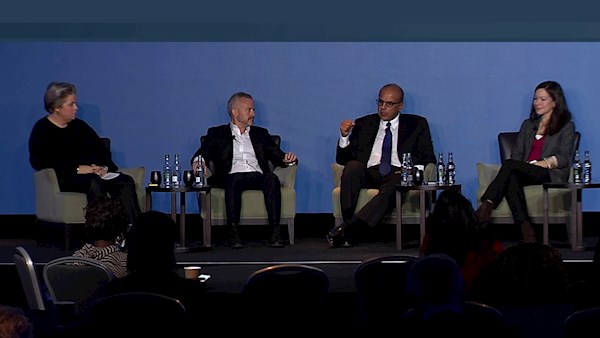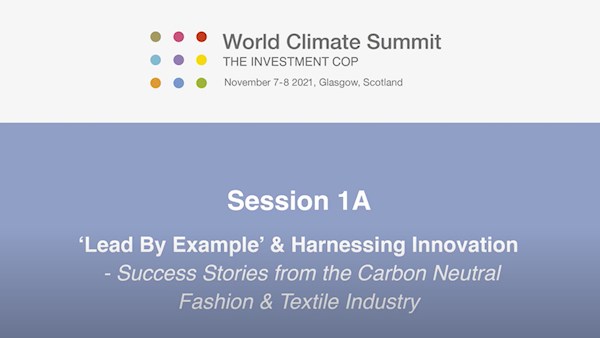
How is Coats Pioneering for a Sustainable Future?
An Interview with Rajiv Sharma, Group Chief Executive, at the World Climate Summit 2021, the Investment COP alongside COP26.
1. How is sustainability changing Coats as a business?
Sustainability is a big issue for the textiles industry. Clothing production consumes vast quantities of natural non-renewable resources, including water and energy. In addition, the industry is a significant emitter of global greenhouse gas emissions.
As the world’s largest supplier of thread, we play a big part in that industry. Coats’ yarns and threads are essential to many of the world’s finest clothes. We are the world’s largest industrial thread manufacturer and for more than 250 years we have been pioneers, setting the standard for quality and performance. Our global footprint is unrivaled, and we are connected to every link in the supply chain, from raw materials suppliers to brands.
Our prominence within the industry brings with it responsibility. We want – and feel a duty – to lead the textiles industry on to a new path of sustainability. We started this journey in 2018, when we set a series of goals that have become the foundations of our approach to sustainability. We focused on ambitious targets set under five priority areas; water, energy, effluent & emissions, social and living sustainably (waste and eco products). Now we are strengthening our commitment, with emphasis on addressing emissions reduction and circularity.
Earlier this year, Coats made the commitment to becoming fully Net Zero by 2050. We have developed a roadmap to get there, will log our progress against a series of milestones and will open source our work to help other companies who face similar challenges.
As we embrace Circularity, Coats will work internally and with all our partners throughout the supply chain to expand our use of eco materials, and create new products and packaging solutions that can be efficiently recycled and reused.
Building on the strong foundation of our original commitments, to develop a more ambitious roadmap, demonstrates how central sustainability is both to Coats’ strategy and to our everyday activity. Sustainability sits at the very core of our business practices.
2. The journey to net zero is a big focus of COP this year. What is Coats doing to reach this goal?
As a company, Coats is committing to halve our emissions in the next decade, and to be net-zero by 2050. Our commitment is comprehensive, encompassing all our emissions under scopes 1, 2, and 3. We also aim to play our part in our industry’s broader journey to net-zero.
Reaching these goals will be challenging. We are committed, and we have a plan, but we will need partners if we are to make it work. And for progress on the broader target of reaching net-zero across the industry, all of us must work together in open-source collaboration to find innovative solutions to common problems.
Our company plan involves seven distinct workstreams, each with a quantified contribution to our achievement of net-zero. They include energy-efficient manufacturing operations, renewable energy procurement, and sustainable upstream and downstream operations. To maintain and track our progress, we have established governance best practices, and identified the KPIs that we will monitor.
In launching this effort, Coats is building on the progress we have already made on sustainability. We draw confidence and lessons from the 2018 commitments we made that by 2022 we would, among other goals, reduce our water usage by 40%, our energy use by 7%, and our waste output by 25%. These remain challenging targets and, though we have made good progress, there is still more to do. We are committed to delivering in each of these areas in 2022 and 2024 which we believe to be a solid foundation on which to raise our ambition. We continue to commit resources and plan to achieve them at the same time as working towards the longer-term goal of net-zero.
3. Another big theme of COP26 is nature positivity, what is Coats doing around this topic?
Around two-thirds of our Scope 3 emissions today come from the goods and materials we purchase to make our products, in particular, the oil-based materials such as polyester and nylon we use in most of our thread. Cutting this use of new oil-extraction-based products is one of the most effective ways we can reduce our carbon footprint and a current focus of our efforts to become more nature-positive.
We have already begun to successfully launch at scale ranges of eco-friendly products, with a great reception from our leading global customers. We launched EcoVerde, our first 100% recycled polyester thread, in December 2018, and it currently accounts for almost 10% of our sales.
But we want to go much further, partly by transitioning more of our to recycled materials and partly by innovating to new solutions, such as new bio-materials that can substitute for the materials we currently use.
We will collaborate with the leading innovators in materials technology to explore how we can partner to develop new approaches, as well as seeking further opportunities to work with our brand and manufacturing partners.
4. A lot of new regulation is focused on cutting down on single-use consumer packaging, what else do you want to see change?
Customer packaging is a big issue, but packaging is an issue throughout the supply chain. We currently use almost 8 million kg of plastic a year just for our supports – the cones at the center of rolls of thread – and that’s just one kind of packaging. So although we are not a consumer-facing company, we also have to address the amount of waste we create as a result of packaging.
We are going to do so with three initiatives that we will be implementing in all of our manufacturing sites around the world. The first is to make as much of our packaging from recycled and recyclable material as possible. Currently 80% of our cardboard and 24% of our plastic cones are made from recycled materials. Whilst this progress to date is positive, we acknowledge that particularly where our plastic cones are concerned, there is significant improvement to be made. We want to increase these proportions, and also create a process to ensure that at the end of its life, all our packaging is then in turn recycled.
Our second initiative will simply eliminate packaging altogether wherever possible, including most of the plastic bags and film we currently use. And the third initiative is to work with our customers to implement a circular program, in which we reuse what we can’t eliminate – in particular, all cardboard boxes and thread/yarn supports. This reuse program has the potential to reduce the volume of new cones we need to buy by 60%.
Together, these initiatives will not only substantially reduce the volume of packaging waste we produce but also reduce the greenhouse emissions associated with our packaging.
Encouragingly, regulation is pushing industry to focus more on end-of-life responsibility for products and packaging, and this is creating an uptick on interest in circularity throughout the supply chain.
5. As you mentioned, circularity has become a key topic both in the fashion industry and in sustainability in general. How is Coats getting involved in this movement?
Coats has spent over 250 years becoming an expert in how to design and produce thread that holds garments together. In this generation, we need to become experts in helping the industry dismantle garments effectively and efficiently for recycling and reuse.
To recycle a garment (and re-use or dispose of the elements that are non-recyclable, such as zips), you need to take it apart and separate the different materials. Currently, that has to be done largely by hand, as the seams need to be unpicked. We have a range of new products that we believe offer the key to overcome the challenges associated with the disassembly stage and so speeding and scaling up the entire recycling process.
Some are already part of our offer, such as EcoVerde, which is made of 100% recycled polyester and so sits naturally within the circular process, and EcoRegen, a 100% lyocell thread that more closely matches the material of the garments, allowing them to be recycled without needing to remove the stitching.
But we are particularly excited by our newest product, EcoCycle, which is launching early next year. Coats EcoCycle is one of the first water dissolvable threads of its kind, designed to dissolve when washed at high temperatures. At the end of a garment’s life, recyclers can wash the garments to dissolve the seams, enabling them to be easily pulled apart into pieces to allow the components to be sorted and recycled separately. EcoCycle thus removes one of the biggest obstacles currently blocking effective recycling programs for clothing and helps to facilitates solutions that support the circular economy.
And we will keep investing and developing to go even further, beyond these exciting existing products, working with recycling partners to create new products that can enable even more efficient and effective circularity.
6. Cross-sector collaboration has been identified as essential to help drive the industry forward. What is the role of industry collaboration, and how is COATS contributing to this?
If we as an industry are to achieve our ambitions and drive rapid progress on sustainability , we have to work together. Collaboration is essential, not only to Coats’ ability to make its bold moves, but to wider progress.
We recognize that we have a lot to learn and areas to innovate in, and are using our deep integration into the value chain to reach out across the entire ecosystem. We are in touch with brands, suppliers, and manufacturers, and also beyond the fashion supply chain, with organizations such as the Ellen MacArthur Foundation, with which we have a strong partnership. And we want to reach further still, to connect with innovators in materials and recycling.
This is a moment of challenge but also energy within the industry. Participants from different sectors and different places in the value chain are coming together in partnerships, through open-source innovation, through collaboration to solve the tremendous problems we face together. At Coats, we will continue to be part of these conversations, to share what we learn and to learn from others. Only by supporting innovation can Coats and the wider textile and clothing industry find a new, more sustainable way forward.

